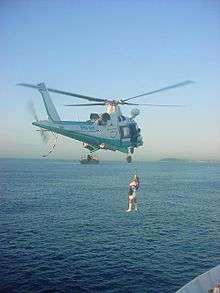Maritime pilot
A maritime pilot, marine pilot, harbor pilot, port pilot, ship pilot, bar pilot, or simply pilot, is a mariner who maneuvers ships through dangerous or congested waters, such as harbors or river mouths. They are navigational experts possessing knowledge of the particular waterway such as its depth, currents, and hazards, as well as being experts in handling ships of all types and size. A Maritime pilot is an expert ship handler who is licensed or authorised by a recognised pilotage authority.
%2C_talks_with_a_Nigerian_pilot_while_navigating_into_Lagos.jpg)
History

The word pilot probably came from Middle French pilot, pillot, from Italian pilota, from Late Latin pillottus; perhaps ultimately from Ancient Greek πηδόν (pēdón, "blade of an oar, oar").[1]
The work functions of the pilot go back to Ancient Greece and Roman times, when locally experienced harbour captains, mainly local fishermen, were employed by incoming ships' captains to bring their trading vessels into port safely.[2]
Pilots had to have quick transport to get from the port to the incoming ships. They initially used their own fishing boats to reach the incoming vessels, but these were heavy working boats, which led to the development of the specialised pilot boat.
In the inland brown water trade another type of pilots are known as trip pilots. Due to the shortage of qualified posted masters these independent contractors fill the holes in the manning schedule on inland push boats on various inland river routes.[3]
Because the act of pilotage needed to be regulated and to ensure that pilots had adequate insurance, the harbours started to use licensed pilots. If a licensed pilot offered his services, an incoming ship was obliged to bring the pilot on board.[2]
A Sandy Hook pilot is a licensed maritime pilot for the Port of New York and New Jersey, the Hudson River, and Long Island Sound. The Sandy Hook pilots have been piloting ships in the New York Harbor for over 300 years.[4] The pilots of New York and Boston faced fierce cold, snow, and ice during the winter. The Great Blizzard of 1888 was so severe that eight pilot boats were actually driven ashore and damaged on the New York harbor. Some of the schooners were lost at sea.[2]
Duties involved

In English law, Section 742 of the Merchant Shipping Act 1894 defines a pilot as "any person not belonging to a ship who has the conduct thereof." In other words, someone other than a member of the crew who has control over the speed, direction, and movement of the ship. The Pilotage Act 1987 governs the management of maritime pilots and pilotage in harbors in the United Kingdom.[5][6]
Pilots are required to have maritime experience prior to becoming a pilot. This includes local knowledge of the area. For example, the California Board of Pilot Commissioners requires that pilot trainees must have a master's license, two years command experience on tugs or deep draft vessels, and pass a written exam and simulator exercise, followed by a period of up to three years training gaining experience with different types of vessel and docking facilities. Following licensing, pilots are required to engage in continuing educational programs.[7]
Normally, the pilot joins an incoming ship prior to the ship's entry into the shallow water at the designated "pilot boarding area" via helicopter or pilot boat and climbs a pilot ladder sometimes up to 40 feet (~12 metres) to the deck of the largest container and tanker ships. Climbing the pilot ladder can be dangerous, even more so in rough seas considering that both the ship to be piloted and the pilot's own vessel are usually moving. With outgoing vessels, a pilot boat returns the pilot to land after the ship has successfully negotiated coastal waters.[8][9][10] Pilots are required by law in most major sea ports of the world for large ships.[11] Pilots use pilotage techniques relying on nearby visual reference points and local knowledge of tides, swells, currents, depths and shoals that might not be readily identifiable on nautical charts without first hand experience in the waters in question.[12]
Legally, the master has full responsibility for safe navigation of their vessel, even when a pilot is on board. If they have clear grounds that the pilot may jeopardize the safety of navigation, they can relieve the pilot from their duties and ask for another pilot or, if not compulsory to have a pilot on board, navigate the vessel without one. In every case, during the time passed aboard for operation, the pilot will remain under the master's authority, and always out of "ship's command chain". The pilot remains aboard as an important and indispensable part of the bridge team.[13] Only in transit of the Panama Canal and in Canada does the pilot have the full responsibility for the navigation of the vessel.[14]
However, in some countries, deck officers of vessels who have strong local knowledge and experience of navigating in those ports, such as a ferry or regular trader, may be issued with a pilotage exemption certificate, which relieves them of the need to take a pilot on board.[15][16]
 Signal flag H (Hotel) is used to signal "Pilot on board"
Signal flag H (Hotel) is used to signal "Pilot on board" Signal flag G (Golf) is used to signal "I require a pilot"
Signal flag G (Golf) is used to signal "I require a pilot"
Compensation
The Florida Alliance of Maritime Organizations reported that Florida pilots salaries range from US$100,000 to US$400,000 annually. This was similar to other US states with large ports.[17] Columbia Bar pilots earn about US$180,000 per year.[18] A 2008 review of pilot salary in the United States showed that pay ranged from about US$250,000 to over US$500,000 per year.[19]
Pilot compensation has been controversial in many ports, including Los Angeles and Long Beach, California, especially regarding pilots who are employed by public agencies instead of acting as independent contractors.[20][21]
Compensation varies in other nations. In New Zealand, according to the government career service, pilots earn NZ$90,000-120,000.[22]
See also
References
Notes
- Online Etymology Dictionary
- Cunliffe, Tom, Pilots: Pilot, The World Of Pilotage Under Sail and Oar Wooden Boat Publications. Brooklin, Maine. 2001
- PUSH THAT BARGE
- Rueb, Emily. "The Channel Masters of New York Harbor". New York Times. Retrieved 18 November 2016.
- Merchant Shipping Act, 1894
- Pilotage Act 1987
- Pilot commission - overview (PDF), Board of Pilot Commissioners for the Bays of San Francisco, San Pablo, and Suisun, 7 October 2011, archived from the original (PDF) on 11 September 2011, retrieved 3 December 2011
- "Shipping Industry Guidance on Pilot Transfer Arrangements Ensuring Compliance with SOLAS" (PDF) (2nd ed.). Marisec Publications. 2012 [2008]. Archived from the original (PDF) on 2 February 2014.
- "Recommendations for the Helicopter Transfer of Marine Pilots". www.heliheyn.de. 9 August 1996.
- Video showing embarkation of helipilot on deck Matz Maersk on YouTube
- U.S. Congress Reports and Documents, Volume 6
- Unique Institutions, Indispensable Cogs, and Hoary Figures: Understanding Pilotage Regulation in the United States BY PAUL G. KIRCHNER AND CLAYTON L. DIAMOND
- Proceedings - American Merchant Marine Conference, Volumes 20-22
- Pilotage Law
- "Pilotage Act 1987". legislation.gov.uk.
- "Pilotage Exemption Certificates". Mobility and Transport - European Commission. 2016-09-22. Retrieved 2019-01-10.
- Peterson, Patrick (1 March 2010). "Harbor pilots steer clear of rule change". Melbourne, Florida: Florida Today. pp. 14A. Archived from the original on 2 April 2015.
- Jacklet, Ben (2009-10-30) [2004-10-19]. "Columbia pilot pay attracts port's eye". Portland Tribune. Retrieved 2010-07-15.
- Dibner, Brent (December 8, 2008). "Review and Analysis of Harbor Pilot Net Revenues and Salary Levels" (PDF). West Gulf Maritime Association. Archived from the original (PDF) on December 29, 2009. Retrieved September 18, 2010.
- Palmeri, Christopher; Yap, Rodney (1 December 2011). "Los Angeles Port Pilots Steer for $374,000 a Year While Long Beach Profits". Bloomberg Businessweek. New York, New York. Retrieved 3 December 2011.
- History of Loodswezen Archived 2014-02-01 at the Wayback Machine about organized marine pilots in the Netherlands. Visited 3 April 2013.
- "Harbour Pilot/Kaiurungi Aka". Career Services/Rapuara. NewZealand.govt.nz. Archived from the original on June 3, 2010. Retrieved September 18, 2010.
IMO.org/pilotage
Bibliography
- Cook, Ian (2010). Those in Peril: A Blue Funnel Story: a Fifty-six-year Love Affair with Ships. Christchurch, N.Z.: Willsonscott Publishing. ISBN 9781877427312.
- Harry Hignett, 21 Centuries of Marine Pilotage. London, March 2013.
External links
| Wikimedia Commons has media related to Maritime pilots. |